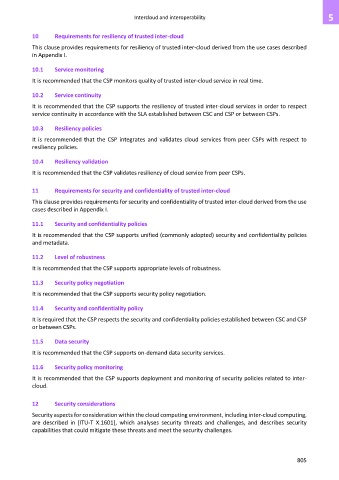Page 813 - Cloud computing: From paradigm to operation
P. 813
Intercloud and interoperability 5
10 Requirements for resiliency of trusted inter-cloud
This clause provides requirements for resiliency of trusted inter-cloud derived from the use cases described
in Appendix I.
10.1 Service monitoring
It is recommended that the CSP monitors quality of trusted inter-cloud service in real time.
10.2 Service continuity
It is recommended that the CSP supports the resiliency of trusted inter-cloud services in order to respect
service continuity in accordance with the SLA established between CSC and CSP or between CSPs.
10.3 Resiliency policies
It is recommended that the CSP integrates and validates cloud services from peer CSPs with respect to
resiliency policies.
10.4 Resiliency validation
It is recommended that the CSP validates resiliency of cloud service from peer CSPs.
11 Requirements for security and confidentiality of trusted inter-cloud
This clause provides requirements for security and confidentiality of trusted inter-cloud derived from the use
cases described in Appendix I.
11.1 Security and confidentiality policies
It is recommended that the CSP supports unified (commonly adopted) security and confidentiality policies
and metadata.
11.2 Level of robustness
It is recommended that the CSP supports appropriate levels of robustness.
11.3 Security policy negotiation
It is recommended that the CSP supports security policy negotiation.
11.4 Security and confidentiality policy
It is required that the CSP respects the security and confidentiality policies established between CSC and CSP
or between CSPs.
11.5 Data security
It is recommended that the CSP supports on-demand data security services.
11.6 Security policy monitoring
It is recommended that the CSP supports deployment and monitoring of security policies related to inter-
cloud.
12 Security considerations
Security aspects for consideration within the cloud computing environment, including inter-cloud computing,
are described in [ITU-T X.1601], which analyses security threats and challenges, and describes security
capabilities that could mitigate these threats and meet the security challenges.
805

